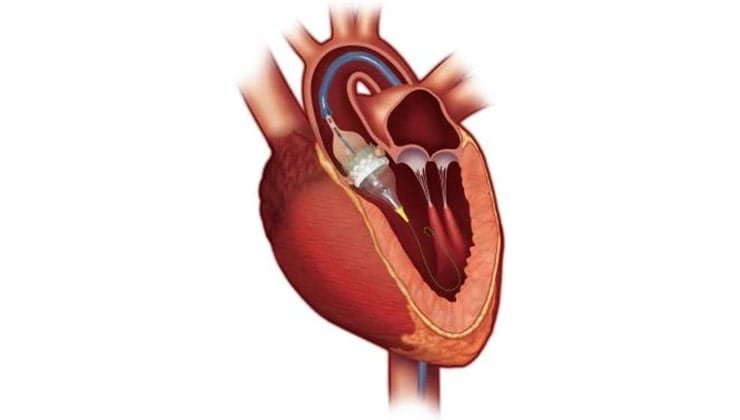Transcatheter Aortic Valve Replacement (TAVR) is a ground-breaking innovation in the treatment of aortic valve stenosis.
In aortic valve stenosis, the aortic valve narrows and restricts blood flow from the heart to the rest of the body.
TAVR is a less-invasive alternative to standard open-heart surgery that provides new hope to patients who are thought to be high-risk or inoperable.
This article dives into the technique, advantages, risks, and future prospects of TAVR, emphasizing its revolutionary role in cardiac treatment.
The TAVR Procedure
Transcatheter Aortic Valve Replacement (TAVR) is a method for replacing the aortic valve in the heart without making any incisions.
The aortic valve regulates the flow of blood from the left ventricle to the aorta, which distributes oxygenated blood throughout the body.
When the aortic valve becomes narrower or damaged (aortic stenosis), blood flow is reduced, causing symptoms such as chest pain, shortness of breath, and exhaustion.
Pre-procedure Evaluation
Before getting TAVR, patients undergo extensive assessment to determine if they are suitable for the operation.
Imaging studies such as echocardiograms, CT scans, and angiograms are used to determine the degree of aortic stenosis as well as the structure of the heart and blood arteries.
Additionally, a multidisciplinary team of cardiologists, cardiac surgeons, and other experts evaluates the patient’s general health state, taking into account criteria such as age, concurrent conditions, and surgical risk.
The Procedure
TAVR is usually done in a catheterization lab or in a hybrid operating room. The technique consists of the following major steps:
- The most frequent method for accessing the heart is the transfemoral route, which involves inserting the catheter into the femoral artery in the groin. Other options include the subclavian artery, direct aortic route, and transapical approach via the chest.
- A guidewire is put through the catheter to reach the aortic valve. The replacement valve, either on a balloon or a self-expanding stent, is moved along the guidewire to the location of the sick valve.
- Once in place, the balloon is inflated (if using balloon-expandable valves) or the self-expanding valve is released , which pushes aside the damaged valve leaflets and anchors the new valve in place.
- Imaging methods such as echocardiography are used to confirm that the replacement valve is working well and to look for any problems, such as a paravalvular leak or vascular damage.
Post-operative Care
Patients usually stay in the hospital for a few days after TAVR. During this period, they are examined for challenges and given pain relief and blood clot prevention drugs.
When compared to open-heart surgery, most patients heal quickly and can resume regular activities within a few weeks.
Candidates suitable to undergo TAVR
TAVR is advised for those with severe aortic stenosis. It was initially designed for individuals who were classified as high-risk or inoperable candidates for regular open-heart surgery.
In recent years, the indications for TAVR have increased to include intermediate-risk individuals, as well as lower-risk patients in specific circumstances.
Benefits of TAVR
TAVR has several advantages, especially for individuals who are considered high-risk for standard surgical valve replacement. These benefits include:
- Minimally Invasive: Unlike open-heart surgery, which needs a sternotomy (chest opening), TAVR is conducted through tiny incisions, causing less stress to the body.
- Shorter Recovery Time: Because TAVR is less invasive, many patients can resume their daily activities considerably sooner than they would following surgical valve replacement.
- Reduced risk of Complications: Complications are reduced for high-risk patients using TAVR as compared to open-heart surgery.
- Improved Quality of Life: Research has shown that TAVR considerably reduces symptoms of aortic stenosis, such as shortness of breath, chest discomfort, and fatigue, resulting in a higher quality of life.
Risks and Complications
All operations and medical procedures have some level of risk. The potential dangers of transcatheter aortic valve replacement (TAVR) may include:
- Bleeding
- Blood vessel issues.
- Issues with the new valve, such as falling out of place or leaking
- Stroke
- Heart rhythm issues and the requirement for a pacemaker
- Kidney disease
- Heart attack
- Infection
- Death
Types of TAVR Valves
TAVR valves are classified into numerous categories, such as:
Balloon expanding valves
These valves are built outside the body and attached to a deflated balloon catheter. Before insertion, inflate the balloon, then deflate it after the valve is in place.
Self-expanding valves
When these valves are implanted inside a patient’s natural valve, they help to sustain blood flow.
Mechanical valves
These prosthetic valves are long-lasting materials and can work for the rest of a patient’s life. However, blood clots can develop on the valve’s flaps and hinges, preventing it from functioning.
TAVR has revolutionized the treatment of aortic stenosis, providing a less invasive option for patients who were previously considered too high-risk for open-heart surgery.
The decision to undergo TAVR is made based on the individual patient’s health, anatomy, and the specific circumstances of their aortic valve disease.
Patients should have a thorough discussion with their surgeon to determine the most suitable treatment option.
Though the risks in TAVR might not be that different from open surgery, the recovery is mind bogglingly fast!
Dr. Nikhil
Schedule your consultation today for TAVR/TMVR and other treatments for Cardiac care at Heart360 Care. Our expert Dr. Nikhil P.J.Theckumparampil is a Gold medalist in MBBS with 17 years of experience in the U.S.



